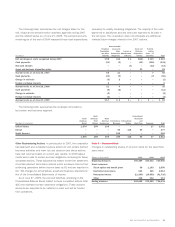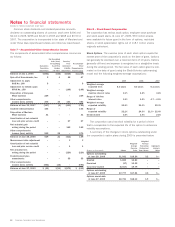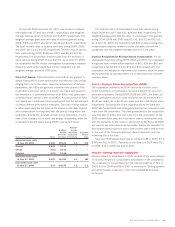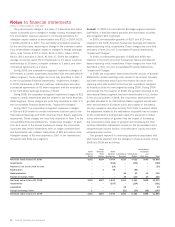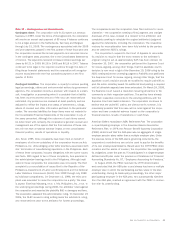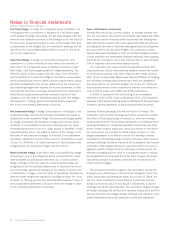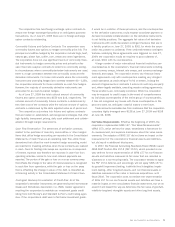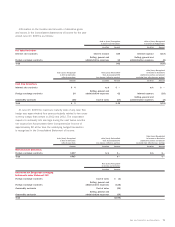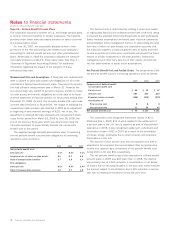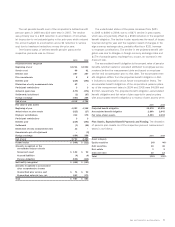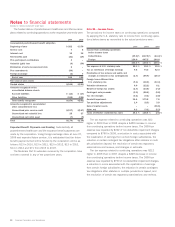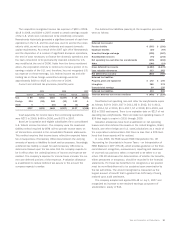Sara Lee 2009 Annual Report Download - page 75
Download and view the complete annual report
Please find page 75 of the 2009 Sara Lee annual report below. You can navigate through the pages in the report by either clicking on the pages listed below, or by using the keyword search tool below to find specific information within the annual report.The corporation has held foreign exchange option contracts to
reduce the foreign exchange fluctuations on anticipated purchase
transactions. As of June 27, 2009 there are no foreign exchange
option contracts outstanding.
Commodity Futures and Options Contracts
The corporation uses
commodity futures and options to hedge commodity price risk. The
principal commodities hedged by the corporation include hogs, beef,
natural gas, diesel fuel, coffee, corn, wheat and other ingredients.
The corporation does not use significant levels of commodity finan-
cial instruments to hedge commodity prices and primarily relies
upon fixed rate supplier contracts to determine commodity pricing.
In circumstances where commodity-derivative instruments are used,
there is a high correlation between the commodity costs and the
derivative instruments. For those instruments where the commodity
instrument and underlying hedged item correlate between 80 – 125%,
the corporation accounts for those contracts as cash flow hedges.
However, the majority of commodity derivative instruments are
accounted for as mark-to-market hedges.
As of June 27, 2009 the total notional amount of commodity
futures and option contracts was $150 and $16, respectively. The
notional amount of commodity futures contracts is determined by
the initial cost of the contracts while the notional amount of options
contracts is determined by the delta adjusted value as of period end.
The corporation only enters into futures and options contracts
that are traded on established, well-recognized exchanges that offer
high liquidity, transparent pricing, daily cash settlement and collater-
alization through margin requirements.
Cash Flow Presentation
The settlement of derivative contracts
related to the purchase of inventory, commodities or other hedged
items that utilize hedge accounting are reported in the Consolidated
Statements of Cash Flows as an operating cash flow, while those
derivatives that utilize the mark-to-market hedge accounting model
are reported in investing activities when those contracts are realized
in cash. Fixed to floating rate swaps are reported as a component
of interest expense and therefore are reported in cash flow from
operating activities similar to how cash interest payments are
reported. The portion of the gain or loss on a cross currency swap
that offsets the change in the value of interest expense is recognized
in cash flow from operations, while the gain or loss on the swap
that is offsetting the change in value of the debt is classified as
a financing activity in the Consolidated Statement of Cash Flows.
Contingent Features/Concentration of Credit Risk
All of the
corporation’s derivative instruments are governed by the International
Swaps and Derivatives Association (i.e. ISDA) master agreement,
requiring the corporation to maintain an investment grade credit
rating from both Moody’s and Standard & Poor’s credit rating agen-
cies. If the corporation’s debt were to fall below investment grade,
it would be in violation of these provisions, and the counterparties
to the derivative instruments could request immediate payment or
demand immediate collateralization on the derivative instruments
in net liability positions. The aggregate fair value of all derivative
instruments with credit-risk-related contingent features that are in
a liability position on June 27, 2009, is $301 for which the corpo -
ration has posted no collateral. If the credit-risk-related contingent
features underlying these agreements were triggered on June 27,
2009, the corporation would be required to post collateral of,
at most, $301 with its counterparties.
A large number of major international financial institutions are
counterparties to the corporation’s financial instruments including
cross currency swaps, interest rate swaps, and currency exchange
forwards and swaps. The corporation enters into financial instru-
ment agreements only with counterparties meeting very stringent
credit standards (a credit rating of A-/A3 or better), limiting the
amount of agreements or contracts it enters into with any one party
and, where legally available, executing master netting agreements.
These positions are continually monitored. While the corporation
may be exposed to credit losses in the event of nonperformance
by individual counterparties of the entire group of counterparties,
it has not recognized any losses with these counterparties in the
past and does not anticipate material losses in the future.
Trade accounts receivable due from customers that the corporation
considers highly leveraged were $138 at June 27, 2009 and $158
at June 28, 2008.
Fair Value Measurements Effective the beginning of 2009, the
corporation implemented SFAS 157, “Fair Value Measurements”
(SFAS 157), which defines fair value, establishes a framework for
its measurement, and expands disclosures about fair value meas-
urements. The adoption of SFAS 157 did not have an impact on the
measurement of the corporation’s financial assets and liabilities,
but did result in additional disclosures.
In 2007, the Financial Accounting Standards Board (FASB) issued
FASB Staff Position FAS 157-2 (FSP 157-2), which provided a one
year deferral for the implementation of SFAS 157 for non-financial
assets and liabilities measured at fair value that are recorded or
disclosed on a non-recurring basis. The corporation elected to apply
the FSP 157-2 deferral, and accordingly, will not apply SFAS 157 to
its goodwill impairment testing, indefinite-lived intangibles impair-
ment testing, other long-lived assets, and non-financial assets or
liabilities measured at fair value in business acquisitions, until
fiscal 2010. The corporation does not believe the implementation
of SFAS 157 for our non-financial assets and liabilities will have a
material impact on the consolidated financial statements, but we do
expect it will impact the way we determine the fair value of goodwill,
indefinite long-lived intangible assets and other long-lived assets.
Sara Lee Corporation and Subsidiaries 73


